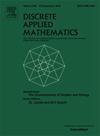Near optimal colourability on (H, Kn−e)-free graphs
IF 1
3区 数学
Q3 MATHEMATICS, APPLIED
引用次数: 0
Abstract
A graph family is near optimal colourable if there is a constant number , such that every graph satisfies , where and are the chromatic number and clique number of , respectively. One may reduce the colouring problem on a near optimal colourable graph family to -colouring problems for . In our previous paper [Y. Ju and S. Huang. Near optimal colourability on hereditary graph families. Theoretical Computer Science 994: 114465, 2024], we give an almost complete characterization for the near optimal colourability for ()-free graphs and give the open problem: “Decide whether the family of ()-free graphs is near optimal colourable, when is a forest with independence number at least 3 and
().” In this paper, we partially solve this open problem. We prove that for every , the family of (, )-free graphs is near optimal colourable if is an induced subgraph of , or for any , and not near optimal colourable if contains an induced claw. Using these results, we give a complete classification on the near optimal colourability of (, )-free graphs, when : the family of (, )-free graphs (, ) is near optimal colourable if and only if is a linear forest.
求助全文
约1分钟内获得全文
求助全文
来源期刊

Discrete Applied Mathematics
数学-应用数学
CiteScore
2.30
自引率
9.10%
发文量
422
审稿时长
4.5 months
期刊介绍:
The aim of Discrete Applied Mathematics is to bring together research papers in different areas of algorithmic and applicable discrete mathematics as well as applications of combinatorial mathematics to informatics and various areas of science and technology. Contributions presented to the journal can be research papers, short notes, surveys, and possibly research problems. The "Communications" section will be devoted to the fastest possible publication of recent research results that are checked and recommended for publication by a member of the Editorial Board. The journal will also publish a limited number of book announcements as well as proceedings of conferences. These proceedings will be fully refereed and adhere to the normal standards of the journal.
Potential authors are advised to view the journal and the open calls-for-papers of special issues before submitting their manuscripts. Only high-quality, original work that is within the scope of the journal or the targeted special issue will be considered.
 求助内容:
求助内容: 应助结果提醒方式:
应助结果提醒方式:


